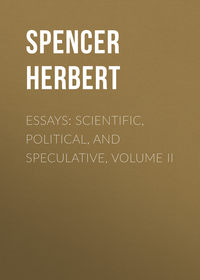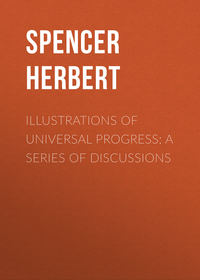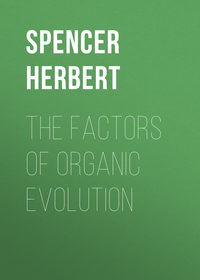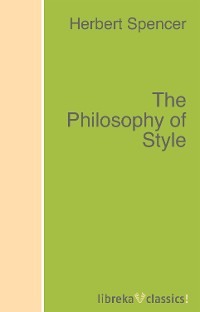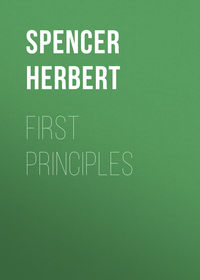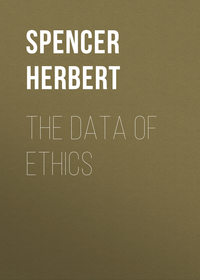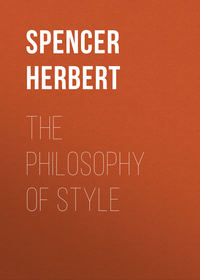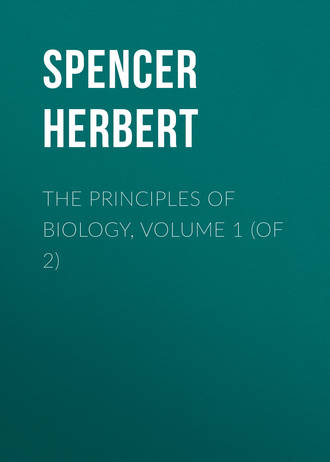 полная версия
полная версияThe Principles of Biology, Volume 1 (of 2)
§ 113a. Other implications concerning the divine character must be recognized by those who contend that each species arose by divine fiat. It is hardly supposable that Infinite Power is exercised in trivial actions effecting trivial changes. Yet the organic world in its hundreds of thousands of species shows in each sub-division multitudinous forms which, though unlike enough to be classed as specifically distinct, diverge from one another only in small details which have no significance in relation to the life led. Sometimes the number of specific distinctions is so great that did they result from human agency we should call them whimsical.
For example, in Lake Baikal are found 115 species of an amphipod, Gammarus; and the multiplicity becomes startling on learning that this number exceeds the number of all other species of the genus: various as are the conditions to which, throughout the rest of the world, the genus is subject. Still stranger seems the superfluous exercise of power on examining the carpet of living forms at the bottom of the ocean. Not dwelling on the immense variety of creatures unlike in type which live miles below the surface in absolute darkness, it will suffice to instance the Polyzoa alone: low types of animals so small that a thousand of them would not cover a square inch, and on which, nevertheless, there has been, according to the view we are considering, an exercise of creative skill such that by small variations of structure more than 350 species have been produced!
Kindred illustrations are furnished by the fauna of caverns. Are we to suppose that numerous blind creatures – crustaceans, myriapods, spiders, insects, fishes – were specially made sightless to fit them for the Mammoth Cave? Or what shall we say of the Proteus, a low amphibian with rudimentary eyes, which inhabits certain caves in Carniola, Carinthia and Dalmatia and is not found elsewhere. Must we conclude that God went out of his way to devise an animal for these places?
More puzzling still is a problem presented to the special-creationist by a batrachian inhabiting Central Australia. In a region once peopled by numerous animals but now made unfit by continuous droughts, there exists a frog which, when the pools are drying up, fills itself with water and burrowing in the mud hibernates until the next rains; which may come in a year or may be delayed for two years. What is to be thought of this creature? Were its structure and the accompanying instinct divinely planned to fit it to this particular habitat?
Many such questions might be asked which, if answered as the current theory necessitates, imply a divine nature hardly like that otherwise assumed.
§ 114. Those who espouse the aboriginal hypothesis entangle themselves in yet other theological difficulties. This assumption that each kind of organism was specially designed, carries with it the implication that the designer intended everything which results from the design. There is no escape from the admission that if organisms were severally constructed with a view to their respective ends, then the character of the constructor is indicated both by the ends themselves, and the perfection or imperfection with which the organisms are fitted to them. Observe the consequences.
Without dwelling on the question recently raised, why during untold millions of years there existed on the Earth no beings endowed with capacities for wide thought and high feeling, we may content ourselves with asking why, at present, the Earth is largely peopled by creatures which inflict on one another so much suffering? Omitting the human race, whose defects and miseries the current theology professes to account for, and limiting ourselves to the lower creation, what must we think of the countless different pain-inflicting appliances and instincts with which animals are endowed? Not only now, and not only ever since men have lived, has the Earth been a scene of warfare among all sentient creatures; but palæontology shows us that from the earliest eras geologically recorded, there has been going on this universal carnage. Fossil structures, in common with the structures of existing animals, show us elaborate weapons for destroying other animals. We have unmistakable proof that throughout all past time, there has been a ceaseless devouring of the weak by the strong. How is this to be explained? How happens it that animals were so designed as to render this bloodshed necessary? How happens it that in almost every species the number of individuals annually born is such that the majority die by starvation or by violence before arriving at maturity? Whoever contends that each kind of animal was specially designed, must assert either that there was a deliberate intention on the part of the Creator to produce these results, or that there was an inability to prevent them. Which alternative does he prefer? – to cast an imputation on the divine character or to assert a limitation of the divine power? It is useless for him to plead that the destruction of the less powerful by the more powerful, is a means of preventing the miseries of decrepitude and incapacity, and therefore works beneficently. For even were the chief mortality among the aged instead of among the young, there would still arise the unanswerable question – why were not animals constructed in such ways as to avoid these evils? why were not their rates of multiplication, their degrees of intelligence, and their propensities, so adjusted that these sufferings might be escaped? And if decline of vigour was a necessary accompaniment of age, why was it not provided that the organic actions should end in sudden death, whenever they fell below the level required for pleasurable existence? Will any one who contends that organisms were specially designed, assert that they could not have been so designed as to prevent suffering? And if he admits that they could have been made so as to prevent suffering, will he assert that the Creator preferred making them in such ways as to inflict suffering?
Even as thus presented the difficulty is sufficiently great; but it appears immensely greater when we examine the facts more closely. So long as we contemplate only the preying of the superior on the inferior, some good appears to be extracted from the evil – a certain amount of life of a higher order, is supported by sacrificing a great deal of life of a lower order. So long, too, as we leave out all mortality but that which, by carrying off the least perfect members of each species, leaves the most perfect members to survive and multiply; we see some compensating benefit reached through the suffering inflicted. But what shall we say on finding innumerable cases in which the suffering inflicted brings no compensating benefit? What shall we say when we see the inferior destroying the superior? What shall we say on finding elaborate appliances for furthering the multiplication of organisms incapable of feeling, at the expense of misery to organisms capable of happiness?
Of the animal kingdom as a whole, more than half the species are parasites. "The number of these parasites," says Prof. Owen, "may be conceived when it is stated that almost every known animal has its peculiar species, and generally more than one, sometimes as many as, or even more kinds than, infest the human body." This parasitism begins among the most minute creatures and pervades the entire animal kingdom from the lowest to the highest. Even Protozoa, made visible to us only by the microscope, are infested, as is Paramœcium by broods of Sphærophrya; while in large and complex animals parasites are everywhere present in great variety. More than this is true. There are parasites upon parasites – an arrangement such that those which are torturing the creatures they inhabit are themselves tortured by indwelling creatures still smaller: looking like an ingenious accumulation of pains upon pains.
But passing over the evils thus inflicted on animals of inferior dignity, let us limit ourselves to the case of Man. The Bothriocephalus latus and the Tænia solium, are two kinds of tape-worm, which flourish in the human intestines; producing great constitutional disturbances, sometimes ending in insanity; and from the germs of the Tænia, when carried into other parts of the body, arise certain partially-developed forms known as Cysticerci, Echinococci, and Cœnuri, which cause disorganization more or less extensive in the brain, the lungs, the liver, the heart, the eye, &c., often ending fatally after long-continued suffering. Five other parasites, belonging to a different class, are found in the viscera of man – the Trichocephalus, the Oxyuris, the Strongylus (two species), the Ancylostomum and the Ascaris; which, beyond that defect of nutrition which they necessarily cause, sometimes induce certain irritations that lead to complete demoralization. Of another class of entozoa, belonging to the subdivision Trematoda, there are five kinds found in different organs of the human body – the liver and gall-duct, the portal vein, the intestine, the bladder, the eye. Then we have the Trichina spiralis, which passes through one phase of its existence imbedded in the muscles and through another phase of its existence in the intestine; and which, by the induced disease Trichinosis, has lately committed such ravages in Germany as to cause a panic. To these we must add the Guinea-worm, which in some part of Africa and India makes men miserable by burrowing in their legs; and the more terrible African parasite the Bilharzia, which affects 30 per cent. of the natives on the east coast with bleeding of the bladder. From entozoa, let us pass to epizoa. There are two kinds of Acari, one of them inhabiting the follicles of the skin and the other producing the itch. There are creatures that bury themselves beneath the skin and lay their eggs there; and there are three species of lice which infest the surface of the body. Nor is this all. Besides animal parasites there are sundry vegetal parasites, which grow and multiply at our cost. The Sarcina ventriculi inhabits the stomach, and produces gastric disturbance. The Leptothrix buccalis is extremely general in the mouth, and may have something to do with the decay of teeth. And besides these there are microscopic fungi which produce ringworm, porrigo, pityriasis, thrush, &c. Thus the human body is the habitat of parasites, internal and external, animal and vegetal, numbering, if all are set down, between two and three dozen species; sundry of which are peculiar to Man, and many of which produce great suffering and not unfrequently death. What interpretation is to be put on these facts by those who espouse the hypothesis of special creations? According to this hypothesis, all these parasites were designed for their respective modes of life. They were endowed with constitutions fitting them to live by absorbing nutriment from the human body; they were furnished with appliances, often of a formidable kind, enabling them to root themselves in and upon the human body; and they were made prolific in an almost incredible degree, that their germs might have a sufficient number of chances of finding their way into the human body. In short, elaborate contrivances were combined to insure the continuance of their respective races; and to make it impossible for the successive generations of men to avoid being preyed on by them. What shall we say to this arrangement? Shall we say that "the head and crown of things," was provided as a habitat for these parasites? Shall we say that these degraded creatures, incapable of thought or enjoyment, were created that they might cause human misery? One or other of these alternatives must be chosen by those who contend that every kind of organism was separately devised by the Creator. Which do they prefer? With the conception of two antagonist powers, which severally work good and evil in the world, the facts are congruous enough. But with the conception of a supreme beneficence, this gratuitous infliction of pain is absolutely incompatible.
§ 115. See then the results of our examination. The belief in special creations of organisms arose among men during the era of profoundest darkness; and it belongs to a family of beliefs which have nearly all died out as enlightenment has increased. It is without a solitary established fact on which to stand; and when the attempt is made to put it into definite shape in the mind, it turns out to be only a pseud-idea. This mere verbal hypothesis, which men idly accept as a real or thinkable hypothesis, is of the same nature as would be one, based on a day's observation of human life, that each man and woman was specially created – an hypothesis not suggested by evidence but by lack of evidence – an hypothesis which formulates ignorance into a semblance of knowledge. Further, we see that this hypothesis, failing to satisfy men's intellectual need of an interpretation, fails also to satisfy their moral sentiment. It is quite inconsistent with those conceptions of the divine nature which they profess to entertain. If infinite power was to be demonstrated, then, either by the special creation of every individual, or by the production of species by some method of natural genesis, it would be better demonstrated than by the use of two methods, as assumed by the hypothesis. And if infinite goodness was to be demonstrated, then, not only do the provisions of organic structure, if they are specially devised, fail to demonstrate it, but there is an enormous mass of them which imply malevolence rather than benevolence.
Thus the hypothesis of special creations turns out to be worthless by its derivation; worthless in its intrinsic incoherence; worthless as absolutely without evidence; worthless as not supplying an intellectual need; worthless as not satisfying a moral want. We must therefore consider it as counting for nothing, in opposition to any other hypothesis respecting the origin of organic beings.
CHAPTER III.
GENERAL ASPECTS OF THE EVOLUTION-HYPOTHESIS
§ 116. Just as the supposition that races of organisms have been specially created, is discredited by its origin; so, conversely, the supposition that races of organisms have been evolved, is credited by its origin. Instead of being a conception suggested and accepted when mankind were profoundly ignorant, it is a conception born in times of comparative enlightenment. Moreover, the belief that plants and animals have arisen in pursuance of uniform laws, instead of through breaches of uniform laws, is a belief which has come into existence in the most-instructed class, living in these better-instructed times. Not among those who have disregarded the order of Nature, has this idea made its appearance; but among those who have familiarized themselves with the order of Nature. Thus the derivation of this modern hypothesis is as favourable as that of the ancient hypothesis is unfavourable.
§ 117. A kindred antithesis exists between the two families of beliefs, to which the beliefs we are comparing severally belong. While the one family has been dying out the other family has been multiplying. As fast as men have ceased to regard different classes of phenomena as caused by special personal agents, acting irregularly; so fast have they come to regard these different classes of phenomena as caused by a general agency acting uniformly – the two changes being correlatives. And as, on the one hand, the hypothesis that each species resulted from a supernatural act, having lost nearly all its kindred hypotheses, may be expected soon to die; so, on the other hand, the hypothesis that each species resulted from the action of natural causes, being one of an increasing family of hypotheses, may be expected to survive.
Still greater will the probability of its survival and establishment appear, when we observe that it is one of a particular genus of hypotheses which has been rapidly extending. The interpretation of phenomena as results of Evolution, has been independently showing itself in various fields of inquiry, quite remote from one another. The supposition that the Solar System has been evolved out of diffused matter, is a supposition wholly astronomical in its origin and application. Geologists, without being led thereto by astronomical considerations, have been step by step advancing towards the conviction that the Earth has reached its present varied structure by modification upon modification. The inquiries of biologists have proved the falsity of the once general belief, that the germ of each organism is a minute repetition of the mature organism, differing from it only in bulk; and they have shown, contrariwise, that every organism advances from simplicity to complexity through insensible changes. Among philosophical politicians, there has been spreading the perception that the progress of society is an evolution: the truth that "constitutions are not made but grow," is seen to be a part of the more general truth that societies are not made but grow. It is now universally admitted by philologists that languages, instead of being artificially or supernaturally formed, have been developed. And the histories of religion, of science, of the fine arts, of the industrial arts, show that these have passed through stages as unobtrusive as those through which the mind of a child passes on its way to maturity. If, then, the recognition of evolution as the law of many diverse orders of phenomena, has been spreading; may we not say that there thence arises the probability that evolution will presently be recognized as the law of the phenomena we are considering? Each further advance of knowledge confirms the belief in the unity of Nature; and the discovery that evolution has gone on, or is going on, in so many departments of Nature, becomes a reason for believing that there is no department of Nature in which it does not go on.
§ 118. The hypotheses of Special Creation and Evolution, are no less contrasted in respect of their legitimacy as hypotheses. While, as we have seen, the one belongs to that order of symbolic conceptions which are proved to be illusive by the impossibility of realizing them in thought; the other is one of those symbolic conceptions which are more or less fully realizable in thought. The production of all organic forms by the accumulation of modifications and of divergences by the continual addition of differences to differences, is mentally representable in outline, if not in detail. Various orders of our experiences enable us to conceive the process. Let us look at one of the simplest.
There is no apparent similarity between a straight line and a circle. The one is a curve; the other is defined as without curvature. The one encloses a space; the other will not enclose a space though produced for ever. The one is finite; the other may be infinite. Yet, opposite as the two are in their characters, they may be connected together by a series of lines no one of which differs from the adjacent ones in any appreciable degree. Thus, if a cone be cut by a plane at right angles to its axis we get a circle. If, instead of being perfectly at right angles, the plane subtends with the axis an angle of 89° 59′, we have an ellipse which no human eye, even when aided by an accurate pair of compasses, can distinguish from a circle. Decreasing the angle minute by minute, this closed curve becomes perceptibly eccentric, then manifestly so, and by and by acquires so immensely elongated a form so as to bear no recognizable resemblance to a circle. By continuing this process the ellipse changes insensibly into a parabola. On still further diminishing the angle, the parabola becomes an hyperbola. And finally, if the cone be made gradually more obtuse, the hyperbola passes into a straight line as the angle of the cone approaches 180°. Here then we have five different species of line – circle, ellipse, parabola, hyperbola, and straight line – each having its peculiar properties and its separate equation, and the first and last of which are quite opposite in nature, connected together as members of one series, all producible by a single process of insensible modification.
But the experiences which most clearly illustrate the process of general evolution, are our experiences of special evolution, repeated in every plant and animal. Each organism exhibits, within a short time, a series of changes which, when supposed to occupy a period indefinitely great, and to go on in various ways instead of one way, give us a tolerably clear conception of organic evolution at large. In an individual development, we see brought into a comparatively infinitesimal time, a series of metamorphoses equally great with each of those which the hypothesis of evolution assumes to have taken place during immeasurable geologic epochs. A tree differs from a seed in every respect – in bulk, in structure, in colour, in form, in chemical composition. Yet is the one changed in the course of a few years into the other: changed so gradually, that at no moment can it be said – Now the seed ceases to be and the tree exists. What can be more widely contrasted than a newly-born child and the small, semi-transparent, gelatinous spherule constituting the human ovum? The infant is so complex in structure that a cyclopædia is needed to describe its constituent parts. The germinal vesicle is so simple that it may be defined in a line. Nevertheless, nine months suffice to develop the one out of the other; and that, too, by a series of modifications so small, that were the embryo examined at successive minutes, even a microscope would not disclose any sensible changes. Aided by such facts, the conception of general evolution may be rendered as definite a conception as any of our complex conceptions can be rendered. If, instead of the successive minutes of a child's fœtal life, we take the lives of successive generations of creatures – if we regard the successive generations as differing from one another no more than the fœtus differs in successive minutes; our imaginations must indeed be feeble if we fail to realize in thought, the evolution of the most complex organism out of the simplest. If a single cell, under appropriate conditions, becomes a man in the space of a few years; there can surely be no difficulty in understanding how, under appropriate conditions, a cell may, in the course of untold millions of years, give origin to the human race.
Doubtless many minds are so unfurnished with those experiences of Nature out of which this conception is built, that they find difficulty in forming it. Looking at things rather in their statical than in their dynamical aspects, they never realize the fact that, by small increments of modification, any amount of modification may in time be generated. The surprise they feel on finding one whom they last saw as a boy, grown into a man, becomes incredulity when the degree of change is greater. To such, the hypothesis that by any series of changes a protozoon can give origin to a mammal, seems grotesque – as grotesque as Galileo's assertion of the Earth's movement seemed to his persecutors; or as grotesque as the assertion of the Earth's sphericity seems now to the New Zealanders. But those who accept a literally-unthinkable proposition as quite satisfactory, may not unnaturally be expected to make a converse mistake.
§ 119. The hypothesis of evolution is contrasted with the hypothesis of special creations, in a further respect. It is not simply legitimate instead of illegitimate, because representable in thought instead of unrepresentable; but it has the support of some evidence, instead of being absolutely unsupported by evidence. Though the facts at present assignable in direct proof that by progressive modifications, races of organisms which are apparently distinct from antecedent races have descended from them, are not sufficient; yet there are numerous facts of the order required. Beyond all question unlikenesses of structure gradually arise among the members of successive generations. We find that there is going on a modifying process of the kind alleged as the source of specific differences: a process which, though slow, does, in time, produce conspicuous changes – a process which, to all appearance, would produce in millions of years, any amount of change.
In the chapters on "Heredity" and "Variation," contained in the preceding Part, many such facts were given, and more might be added. Although little attention has been paid to the matter until recent times, the evidence already collected shows that there take place in successive generations, alterations of structure quite as marked as those which, in successive short intervals, arise in a developing embryo – nay, often much more marked; since, besides differences due to changes in the relative sizes or parts, there sometimes arise differences due to additions and suppressions of parts. The structural modification proved to have taken place since organisms have been observed, is not less than the hypothesis demands – bears as great a ratio to this brief period, as the total amount of structural change seen in the evolution of a complex organism out of a simple germ, bears to that vast period during which living forms have existed on the Earth.




